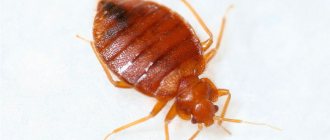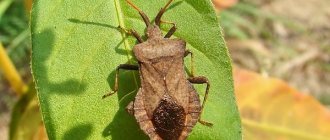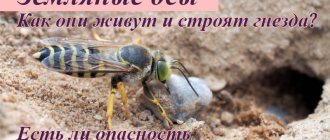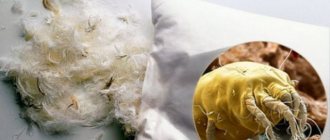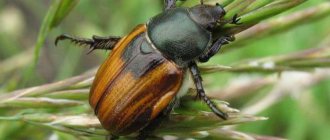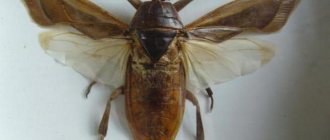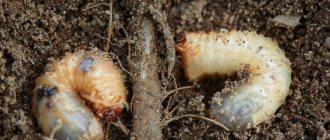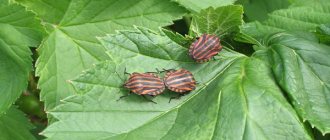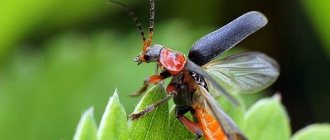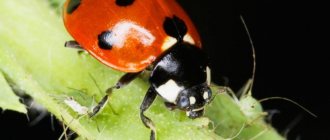The bedbug (lat. Cimex Lectularius) is a type of bedbug, an obligate synanthropic blood-sucking insect, an ectoparasite of humans and warm-blooded animals, feeding only on blood. It is called “bed” because its favorite habitat is the human bed. The second unofficial name for these parasites is “room bugs”; They are called so because of their direct dependence on a person and his home. Belongs to a type of arthropod from the class of insects, the order Hemiptera, they cannot fly.
Let's consider the characteristics of bedbugs, their lifestyle and impact on humans, as well as methods of combating this domestic parasite.
What does a bed bug look like?
The appearance of a bedbug is characterized primarily by a flattened body, which helps it get between fabric folds without the risk of being crushed by a person. The length of the bug is from 3 to 8.5 mm, depending on gender and blood saturation; females are larger in size than males. Body color ranges from dark brown to dirty beige and even rusty.
In addition to the proboscis for piercing the skin, the bug has sharp bristles for secreting anesthetic saliva into the bite site.
Photo of a bug under a microscope. A proboscis emerges from the front of the head to pump out blood.
Bedbugs are most active at night, especially when they are hungry. A well-fed bedbug increases in size, becomes less agile and more vulnerable; it is the well-fed, crushed bedbugs that leave blood marks on the pillowcase.
Traces of blood may remain on the pillowcase if you crush a well-fed bug in a dream.
Danger of bites
Researchers are still debating why bed bugs are dangerous to humans. So far, it has not been possible to scientifically prove the fact that bedbugs transmit infections. However, assumptions regarding the fact that arthropods can infect humans with smallpox, hepatitis B, tularemia, and anthrax still exist. Linen parasites cause the greatest harm to humans through their bites. One bug can leave a chain of up to seven bites in a row on an adult or child. By the way, parasites prefer children to adults. Babies have more delicate skin that is easier to bite through.
The table lists the main dangers that bedbug bites entail and how to combat them. But before taking any medications, consult your doctor. And immediately after detecting damage to the skin, treat the bite site with an antibacterial agent (spray, liquid or ointment), and apply cold.
Table - Why bedbug bites are dangerous
| State | The Right Action |
| Allergy | — Primary treatment of the affected skin area; - taking an antihistamine |
| Anemia (in young children) | — Primary disinfection; — consultation with a pediatrician; - taking vitamins high in iron |
| Anaphylactic shock | Urgent ambulance call |
Despite the unproven hypothesis that bedbugs are carriers of diseases, it is better not to touch the bite site with dirty hands, and it is advisable to treat the wound yourself - even before consulting your family doctor.
Stress as a consequence
Among all the consequences of bedbug bites, the most serious and difficult to treat is stress. The reasons for its development may be as follows.
- Insomnia. As well as a total lack of sleep due to insect attacks at night.
- Depression. Usually develops after prolonged stress in squeamish people. The thought of sleeping on a bed with bedbugs haunts a person, exhausts him psychologically.
- Nightmares. For young children, bedbug bites are even harder to come to terms with. It is not always possible to explain to the baby what exactly is happening and when it will stop. The child begins to live in a parallel reality, new fears appear, and colorful dreams give way to nightmares.
Bed bug lifestyle
The bug leads a parasitic nocturnal lifestyle; both females and males with larvae feed on blood. The main time for an attack on a sleeping person is from 3 to 8 am. During the day, these insects hide in the mattress, under the wallpaper, behind the baseboards, in books, in clothes and beds. During the day they come out into the light extremely rarely, only in case of severe hunger. They are able to move from one room to another through ventilation systems, as well as along walls both inside and outside the apartment. The speed at which an adult bedbug travels 1 meter is 1 minute.
Bedbugs have a well-developed sense of smell, which helps them find victims and places of shelter. For example, they can smell the clothes you wear most often, such as a dressing gown, and hide in it.
What do bed bugs eat?
Bed bugs feed exclusively on blood. They do not need water and food to live, like cockroaches. Not only females drink blood (like mosquitoes), but also males with larvae.
An adult can drink up to 7 mg of blood at a time, and a larva can drink less than 1 mg. Parasites feed approximately once a week. If a person is not nearby, they can bite cats, dogs, rodents and even birds.
How long do bed bugs live?
The average lifespan of a bed bug is 1 year. In extreme situations, for example, in the event of a sudden cold snap or a person leaving the apartment for a long time, they can fall into a state of hibernation and spend more than a year in it.
At what temperature do bedbugs die?
Temperature at which bedbugs and their clutches die: +50˚С (temperature must be maintained for at least 10 minutes).
Negative temperature at which a colony of bedbugs dies along with their eggs: -25˚С (the temperature must be maintained for at least 2 hours). Frost down to -10˚C is practically not scary for bedbugs; they simply hibernate.
Comfortable temperature for bed bugs to live and reproduce: +20-30˚С. This is the temperature maintained in apartments and private houses.
Agricultural pests
Phytophagous bugs are a type of insect that feeds on the sap of fruit plants and cereal crops. Colonies grow quickly, so damage from their activity reduces the volume and quality of the harvest.
Cabbage bug
Eurydema has a hard shell, an oval flattened body, reaching a length of less than 1 cm. The color is contrasting - in the area of the scutum and elytra, the exoskeleton is covered with symmetrical red and black patterns. They pose a threat to plants of the Cruciferous family. Females lay up to 300 eggs. Capable of destroying a cabbage crop in a few days. Insect activity increases with rising air temperatures.
Rapeseed bug
The insect belongs to the shield family. The pattern on the exoskeleton is variable, consisting mainly of light and dark spots, which can be blue-black, green, beige, orange or red. The white belly turns black after wintering. Body length - 6-9 mm. The pest affects cruciferous crops: radishes, rutabaga, turnips.
Light green stink bug
The body is painted green, length - from 12 to 15 mm. Before wintering, the stink bug changes its color to bronze, and in the spring it returns to the bright green shade of its shell. The prothorax is concave. The bug settles on deciduous trees and berry bushes. Poses a threat to raspberries and cereal crops.
Lined stink bug
The insect's chitin is bright red and orange with black longitudinal lines. The second name is the Italian bug. The body length reaches 10-11 mm. There are black mustaches on the head. Insects are classified as phytophages, as they feed on the foliage of shrubs and trees. They eat green shoots of fruit plants.
Attention! The larvae of the scale insect eat the inflorescences of dill, carrots and parsley.
Harmful turtle
Insects have the following features:
- hard, durable exoskeleton shell;
- oval shaped body;
- small size - up to 1.3 cm;
- The coloring is dirty, a mixture of yellow, brown and dark gray.
In winter, it hides in the forest thicket, where it buries itself in fallen leaves. On agricultural land it prefers to stay in warm outbuildings with reserves of cereal crops. Fields with rye and wheat are affected.
Important! Under the influence of the saliva of a harmful turtle, the structure of gluten in cereal crops changes, the ripening speed and quality of the crop decreases.
Berry bug
Insects are polyphagous. They prefer to suck the juice of berries, flowers and leaves of ornamental and oil-bearing plants, and fruit trees. After this, the buds and leaves dry out, the fruits fall or quickly deteriorate. The berry bug reaches 12 mm in length, the body is colored reddish-brown. The surface of the exoskeleton is covered with chitinous hairs. It is easily distinguished by its characteristic black and white rim along its abdomen.
Marbled bug
The insect is a dangerous pest that affects up to 300 plant species. They emit a pungent, unpleasant odor that repels birds and rodents. The body of the bug is pear-shaped. There are brown streaks of varying degrees of intensity on the back, which creates the effect of a marble pattern. With the onset of frost, bedbugs move into heated rooms. In the spring they reproduce quickly, laying up to 20-30 eggs at a time. Up to 3 generations are hatched per year.
Reference! From July 1, 2022, the Eurasian Economic Union included marbled bugs in the list of quarantine objects.
Reproduction and development of bed bugs
Mating of bedbugs occurs through traumatic insemination: the male pierces the female’s abdomen with his genitals and injects seminal fluid there. After a couple of weeks, the female begins to lay eggs, up to 5 eggs per day. Over the course of her life, a female can lay 250 to 500 eggs.
The development of an insect from an egg to the adult stage takes 30-40 days, and under difficult conditions (for example, at low temperatures) up to 100 days. The larvae immediately begin to look for food, they need to drink a whole portion of blood in order to move to the next stage of development and undergo molting.
External data and characteristics of the parasite
The linen bug differs from midges and other species of its own kind by its inability to fly. Born to crawl and suck the blood of living things, it has a clearly segmented abdomen. If you look closely, it seems as if his entire miniature body is tied with shiny belts and divided into striped segments.
- Head. Has the shape of a triangle. Below there is a long proboscis, which is essentially jaws fused together. True, all this can be seen only under a microscope. The proboscis is sharp enough to pierce human skin. But it cannot pierce the skin of cattle or dogs of large and medium breeds.
- Length. The body length of a hungry insect does not exceed 3 mm. However, as it becomes saturated, the body stretches and lengthens. After gorging themselves, bed bugs reach more impressive sizes - up to 8 mm.
- Form. When hungry, bed bugs look like a flattened cake. But the insect, which has managed to feed on the blood of its victim, noticeably rounds, stretches, turning into a tiny barrel.
- Color. The shell is brown or red-brown with a brown tint. And here, too, everything depends on the satiety of the creature. A hungry bug is lighter than its well-fed counterparts, but after a meal it also takes on a deep dark shade.
The parasite's proboscis has two separate valves. One is designed to absorb blood, and the second is to introduce an analgesic, a substance that relieves pain, into a hole made in the skin, allowing the insect to strike the victim as unnoticed as possible.
Features of life
The life cycle of a bed bug is quite monotonous and lasts on average 12 months. Particularly tenacious representatives of the species live for a year and three months.
- Pairing. A female may have only one mating process in her life. The male “transplants” his seed into the chosen one in a traumatic way. In fact, he pierces her abdomen with his genitals to share genetic material. The female periodically lays eggs if she considers the surrounding conditions favorable for “children.” On average, she lays up to five hundred eggs during her life.
- Transformation of an egg into a nymph. After a week or two, the egg turns into a nymph, that is, into a larva. The next transformation will occur only when the nymph drinks a full portion of human blood. Compare: the female drinks 7 ml of “food” in one sitting, and the nymph drinks no more than 0.3 mg.
- Incubation period. Depending on conditions, the transformation of an egg into a mature individual takes from a month to 100 days.
- Period of suspended animation. Bed bugs feed on human blood. Sometimes - the blood of bats and domestic animals (those whose skin can be bitten through). If an insect remains hungry for a long time, it goes into hibernation - suspended animation. Bed bugs can live without food for up to a year. But as soon as food begins to loom on the horizon, they immediately awaken from sleep and begin to act instantly.
At a temperature of 50 °C, bed bugs die. And instantly. These creatures are more resistant to frost than to heat. For an egg to die, the air temperature in its habitat must remain at –30 °C for at least two to three days.
Differences from other insects
Due to ignorance, the bedbug can easily be confused with other insects. For example, with ants, which nymphs (parasite larvae) look like, or with fleas. Four main differences will help you get to the bottom of the truth.
- Lack of wings. If an insect has wings, it is most likely a cockroach. Or, alternatively, any other insect that has entered the house from the street.
- Inability to jump. A miniature bug that dashingly jumps from object to object is a flea. A real laundry parasite can neither jump nor fly. In his arsenal of talents there is only prosaic crawling.
- No constrictions in the abdominal area. If the insect you find has such a constriction, then it is an ant.
- The presence of six legs. Flat, round, small bugs with eight legs are mites. They are extremely dangerous, but they do not settle in human habitation and do not form nests in sofas.
Bedbugs are often confused with cockroach larvae. However, the latter have a characteristic difference - a double tail (a bifurcation in the lower part of the abdomen). Biting parasites have nothing like this.
Differences between bedbugs and other insects in the house
Male bedbugs also feed on blood, although in some insect species only females feed on blood in order to be able to reproduce.
Bed bugs are often confused by name with bed dust mites. Dust mites are very small and cannot bite through human skin; they live in pillows and other parts of furniture. They feed on microscopic particles of skin that fall off our bodies. It is unlikely that you will be able to see a dust mite with the naked eye, but it still causes harm: a person can develop an allergy from its waste products, which is confirmed by tests, and this is what is written in the diagnosis “dust mite allergy.”
Dust mite under a microscope
Unlike ants, bedbugs do not build nests and do not form colonies; they prefer to randomly accumulate near a food source, usually near the place where a warm-blooded living creature spends the night. Ants do not feed on human blood, but can only bite in defense.
Unlike fleas, bedbugs are larger in size and cannot jump. Traces of their vital activity are easier to detect than to understand that there are fleas in the apartment. Scars from flea bites most often appear on the legs, in contrast to marks from bedbugs, which can also cover the upper body.
Can they live in clothes?
Bloodsuckers have a good sense of smell and are attracted to the smell of the human body. They easily find people's everyday clothes where they build their nests. They prefer things with numerous pockets, folds and seams.
Bedbugs can live in human clothing.
Which one do they like?
Parasites choose wardrobe items that are in direct contact with the human body: pajamas, shirts, underwear and other home clothes. In this case, the material from which it is made matters. For example, pests do not like fleecy products because they cannot cling to them with their paws, which deprives them of the ability to move. They do not distinguish other fabrics.
How to determine that there are bedbugs in an apartment?
It is not difficult to determine the presence of bedbugs in a private house, apartment or dorm room; pay attention to the following signs of their presence:
- Black dots on the mattress, sheets, under the pillow - dark-colored bedbug feces that look like traces of a black pen or felt-tip pen. Make a light bed, this will make it easier for you to detect the presence of parasites, and the traces will be washed off.
- Eggs, full or empty, as well as fragments of the shell of the bedbug larva, which it sheds, moving to the next stage of development.
- Traces of multiple bites on the body. The bug bites not just once, but several times, so many bites will be noticeable on one area of the skin. You are unlikely to be able to feel the moment of the bite, because the bug injects a “painkiller” under the skin.
- A visual inspection of the bed at night will show whether there are bloodsuckers in it. Set your alarm for 5am, get up, turn on the lights, and examine your bedding.
Photos of bedbugs of all ages
Bed bugs are parasitic insects with a flattened body 8 mm long. The color of insects can be dirty yellow or dark brown. After the insect is saturated with blood, the body inflates and acquires a scarlet color. Bed bugs have 6 limbs. The larvae externally resemble smaller mature individuals. Newly hatched larvae have a transparent body. Therefore, they are almost impossible to notice on the surface. Bedbug eggs look like small grains of rice, 1 mm long. When crushed they emit an unpleasant odor. Many people find bites on their bodies, the origin of which is attributed to mosquitoes.
Causes of bedbugs in the house
Many people think that bedbugs only grow in dirty, unkempt rooms, but this is not true. They are able to take root in any room, regardless of the sanitary situation. Where do they come from? List of main reasons:
- from neighbors who allowed unsanitary conditions in the apartment;
- from pets walking on the street;
- from a hotel or hostel, they can come home with you in a suitcase with clothes;
- from used furniture or equipment, purchased on Avito or brought from the trash.
Interestingly, bedbugs cannot independently move along the street from one private house to another. Therefore, if bedbugs have appeared in a private home, be sure that you brought them yourself on some things, furniture or clothing.
Is it possible to protect your home?
100% ways to protect homes from bedbugs have not yet been invented. They can enter the apartment through the hood or through cracks in the slabs. Of course, you can secure the ventilation grilles by covering them with a thick mesh and sealing the cracks. But no one is immune from “picking up” a bedbug in a hotel, public transport, or while visiting.
The only thing that can be protected is the bed and mattress. This can be done by using special traps and a protective cover of the HECTOR brand.
The traps have a rough outer surface that abruptly turns into a groove with smooth walls. Each of the bed legs should stand inside such a trap. Since bed bugs are insects that can only crawl, the only way into your bed is through the legs of the bed.
Protective mattress cover Hector It is a completely sealed cover with a micro-zipper. By putting it on the mattress, you will not allow bed bugs to settle inside, which means you will save it in case the apartment is infested with insects. The cover consists of two layers. The inner and most important one is made of a special membrane, ensuring 100% tightness, and the outer one is made of 100% cotton. It is important to note that the membrane of the inner layer breathes well and does not creak.
Also, if your sleeping place is already infested with insects, you can save the mattress, since by wearing such a cover, the bed bugs that are already inside will be “walled up” and they will not have access to food.
What can a bedbug be confused with?
It would seem that a detailed description of the appearance of a bug makes it easy to distinguish it from any other insects, harmful or not. However, the variability in the appearance of the parasite, which allows for serious variation in both size and body color, often leads to confusion. For example, quite often a well-fed bug can be mistaken for a cockroach. Photos of both insects are posted below, with the bedbug on the left and the cockroach on the right.
The similarity between the two parasites is obvious. They have similar sizes, similar coloration of an elongated segmented body. The main differences lie in several parameters. Firstly, the bug's body looks more rounded. Secondly, it darkens only after feeding. Thirdly, cockroaches are much more mobile and fast than bed bugs, which move at a low speed even in a hungry state, and are generally inactive when well-fed.
Another parasite with which the bedbug is often confused is the linen louse. Confusion often arises when comparing insect larvae. Just look at the photo of a linen lice and compare it with the images above.
To combat different insect pests, various methods and means are used. Therefore, it is extremely important to know what a particular pest, including a bed bug, looks like, and to be able to distinguish them from each other. To do this, you should consider in detail the most important external signs of bedbugs at different stages of their life cycle.
Harm from bed bugs to humans and animals
In addition to irritation and redness of the skin, inflammation may also appear at the sites of bedbug bites if an infection occurs during resorption. Multiple bedbug bites can lead to the development of an allergic reaction and the appearance of a rash, as a result of which the affected skin will be very itchy and interfere with a full life.
There is an opinion that bedbugs carry dangerous diseases such as typhoid, smallpox, and hepatitis. But the facts of infection have not been proven.
For pets, severe harm from bedbugs is also unlikely; bald spots may appear due to the pet scratching the bite site.
When to turn to professionals?
If you have already used all the methods listed above, and you have not been able to get rid of bed bugs, then you will have to turn to professionals. There are insecticides that are approved by Rospotrebnadzor and approved for use by professional services. Specialists will arrive and carry out extermination treatment against bed bugs. In our arsenal of disinfectants for bedbugs there are 5 different drugs for these parasites. And only a specialist with extensive experience can correctly select the remedy that is needed specifically in your case.
Symptoms of bed bug bites
The symptoms are individual for everyone: some do not notice them until they see red dots on the body, while others begin to experience severe discomfort due to itching. Unlike a mosquito bite, the mark of a bug remains longer and is distinguished by bright redness with characteristic compaction and swelling.
You can only feel the moment of the bite if the larva is biting, because it has already developed an anesthetic secretion.
In another article, we described in detail how bedbugs bite. The link will open in a new tab.
If the skin is very swollen and the redness has spread far beyond the damage, then you are allergic to bedbug bites. The following symptoms may appear:
- general weakness in the body;
- nausea, vomiting;
- dizziness;
- muscle spasms;
- lack of air.
If you have these symptoms, immediately take an antihistamine and consult a doctor!
If there are no allergies or complications, it will be enough to disinfect the damage with alcohol or soda solution and apply Fenistil or other gel with a healing and soothing effect.
The Gektor company has released a special gel to eliminate marks from bedbug bites. Gel Hector consists of natural ingredients and helps relieve inflammation and prevents scratching of damaged skin. The disinfecting properties of the drug help speed up the healing of wounds, and the nutrients return the skin to a healthy color. A 50 ml tube costs about 230 rubles.
Habitats of bloodsuckers
In everyday life, bedbugs are called differently: bed bugs, sofa bugs, house bugs, furniture bugs, clothing bugs. These are all one type of insect. The name depends on where they are found.
Bedbugs live under carpets.
Blood-sucking parasites settle in close proximity to the main source of food - humans. They often make nests not far from his sleeping place: in bedside tables, cabinets, sofas, beds, under mattresses. Thanks to their flattened body, arthropods are able to penetrate into the smallest crevices. At the same time, they choose warm, dark and hard-to-reach places:
- behind ceiling panels;
- under baseboards, window sills;
- between books on shelves;
- behind paintings, wall clocks;
- under wallpaper, carpets.
In some cases, pests live in the housings of household appliances, behind heating radiators, inside sockets and switches.
How to find and signs of their presence
The first thing to think about infesting an apartment with bedbugs is when bite marks appear on the residents’ bodies. These are red spots with a black dot in the center (the puncture site) and are often accompanied by itching. If you find them, you should start searching for harmful insects.
Using a flashlight, they examine their favorite habitats. The bugs present there will scatter, because they cannot stand bright light.
More often in the nests you can see not the bloodsuckers themselves, but signs of their vital activity:
- discarded shells - scraps of shells after molting larvae that look like husks;
- excrement (feces) – small black balls with an unpleasant odor;
- empty egg shells - formations similar to small grains of rice, with a hole for the larvae to exit.
You may notice signs of bed bugs.
Sometimes brown stains remain on the bed linen. These are drops of blood that are formed when a sleeping person crushes saturated parasites.
If there are too many bedbugs, a specific smell appears in the room - the aroma of old cognac or soured raspberries. The residents themselves do not always feel it, but strangers immediately notice.
Effective modern remedies for bedbugs
To be honest, traditional methods, physical and mechanical effects are practically useless in the fight against bed bugs; they will only rid the house of parasites for a short time and force them to take cover for a while. Traditional recipes and herbs are good only for preventing the appearance of insects, but not for removing them.
Modern drugs are very effective and can destroy bloodsucking bedbugs in one or two applications. The most popular and suitable product on the market now is HECTOR powder.
There are quite a lot of reviews on the Internet from people who have dealt with the problem of bedbugs with Hector. From them it is clear that the product really works, but there are several nuances. Due to its powder form, “dust” may form during processing, and it must take at least two weeks to achieve results.
There is an opinion that the most effective way to get rid of bedbugs in an apartment once and for all is to call a pest control service. But, unfortunately, not all services are conscientious about their work. Many of them are aimed only at obtaining maximum profits, saving on the quality of the funds used. Someone deliberately does not complete the treatment so that the client calls the “specialist” again. Now you can easily cope with insects on your own, since all methods and means are freely available. However, the choice is yours.
It is possible to remove bedbugs, but protecting yourself from their appearance is quite difficult, so be attentive to redness on your body and stains on your bed linen, then you can begin to destroy the parasites at an early stage, when they have not yet had time to breed.
Is it possible to crush a parasite with your hands?
Bedbugs are rather fragile insects, but their flat body is given to them by nature just so that they survive, because it is quite inconvenient to catch a flat object and try to crush it. However, this can be done even in this state. It is, of course, more difficult to do this with your fingers.
Bedbugs can easily be choked by your fingernails, like fleas, so killing them this way is quite easy and simple. It simplifies even more when the parasites drink blood. Their abdomens swell to a size that is sometimes twice the size of the bedbugs themselves, after which they turn into a kind of capsule with blood, which is not difficult to simply flatten with your finger.
Sometimes this can be done even unconsciously, simply by leaning your body on a well-fed bug in a dream. You can notice this by small specks of blood. It is even easier to crush young bedbugs, because their body coverings are fragile and soft.
How to get rid
To decide on the method of destruction, you need to understand how many parasites live in the apartment. To get rid of bedbugs yourself, you can use insecticides, among which are the following:
- liquid Karbofos;
- liquid Executioner;
- spray Klopomor;
- pencil Mashenka;
- Get microcapsule product.
You can fight bedbugs in the following ways:
- Freezing or heat treatment. At the same time, the heating system may suffer from the cold, and renting a heat gun is expensive.
- Collection with a vacuum cleaner or by hand. This method is labor-intensive and not very effective.
The most reliable way to get rid of parasites is to call an exterminator. Specialists come with special equipment and products that are toxic to insects but safe for humans. Since these bloodsucking creatures quickly migrate from one apartment to another, it is advisable to simultaneously treat the entire entrance.
In order for pest control to bring maximum results, you should move the furniture away from the walls and free the edges of the carpets before the specialist arrives. All food, dishes and personal hygiene items must be removed from the house. After treatment, the apartment is wet cleaned and ventilated.
Methods of destruction
Although there are many methods to combat bloodsuckers, getting rid of them is not easy. This is explained by the extraordinary vitality and high fertility of insects. It is enough for only one female to survive for a new generation to breed, despite all the measures taken.
Therefore, to effectively destroy bloodsuckers, it is advisable to combine various methods.
High and low temperature treatment
Pests die at both high (more than +45°C) and low (less than -25°C) temperatures. To get rid of clothing bugs, clothes can be hung out in the cold in winter, and in the sun in summer. Alternative methods of temperature exposure:
- boil the laundry or wash it in hot water;
- iron clothes;
- steam using an iron or steamer;
- place things in the freezer for several hours.
To get rid of bedbugs, you need to iron your clothes.
The best method is the use of special steam generators, which not only destroy insects, but also do not harm fabrics (unlike washing and boiling). If such a device is not available, it can be replaced with a simple device: attach a hose or rubber tube to the spout of the kettle and steam the clothes for a few minutes.
Chemicals for destruction
To control pests, you can use chemicals that are available in the form of aerosols, sprays, liquid solutions, and powders. The most effective of them: “Raptor”, “Clean House”, “Combat”, “Raid”, “Tsifoks”, “Karbofos”, etc.
To remove bedbugs, you need to:
- Treat things with insecticide (according to the instructions). It is advisable to do this on the balcony or street. It is recommended to wear a mask to protect your respiratory tract.
- Place the laundry in a plastic bag.
- When the effect of the drug ends, wash the treated clothes and hang them outside for airing.
Folk methods of struggle
Folk remedies are widely available, cheap and easy to use. The main disadvantage is that they do not destroy pests, but only scare them away from places where clothes are stored.
Wormwood repels pests from clothing storage areas.
This effect is exerted by fragrant herbs and shrubs: wormwood, wild rosemary, lavender, tansy, mint. Their fresh branches should be placed on shelves with laundry. Alternative options are to rinse things in a decoction of herbs or treat cabinet doors with essential oils. To enhance the repellent effect, you can combine different plants.
When using natural repellents, you need to take into account a number of nuances:
- they are effective only in combination with other means;
- clothes acquire a specific smell that is not easy to get rid of;
- tansy, wild rosemary and wormwood can be dangerous for humans and domestic animals because they contain toxic substances.
Substances with a pungent odor are also suitable for repelling pests: ammonia, vinegar, turpentine. You need to soak or rinse things in a solution with the addition of these products.
